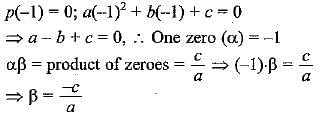Class 10 Exam > Class 10 Questions > If p(x) = ax2 + bx + c and a + c = b, then on...
Start Learning for Free
If p(x) = ax2 + bx + c and a + c = b, then one of the zeroes is
- a)b/a
- b)c/a
- c)-c/a
- d)-b/a
Correct answer is option 'C'. Can you explain this answer?
| FREE This question is part of | Download PDF Attempt this Test |
Verified Answer
If p(x) = ax2 + bx + c and a + c = b, then one of the zeroes isa)b/ab)...

Most Upvoted Answer
If p(x) = ax2 + bx + c and a + c = b, then one of the zeroes isa)b/ab)...
Here is the solution to your question:

P.S. You can understand all the important definitions and formulas of Quadratic Equations by going through the doc:
Free Test
FREE
| Start Free Test |
Community Answer
If p(x) = ax2 + bx + c and a + c = b, then one of the zeroes isa)b/ab)...
Solution:
Given, p(x) = ax^2 + bx + c and ac = b
Let the roots of the quadratic equation be α and β.
Sum of the roots, α + β = -b/a
Product of the roots, αβ = c/a
To find one of the zeroes, let's assume that α = k
Then, β = c/(ak)
As ac = b, we get c = b/a
Substituting the values of α and β, we get
k + c/(ak) = -b/a
ak^2 + c = -bk/a
Multiplying both sides by a, we get
ak^2 + ac = -bk
Substituting c = b/a, we get
ak^2 + b = -bk
Simplifying further, we get
ak^2 + bk + b = 0
This is a quadratic equation in k, which can be solved using the quadratic formula.
The discriminant of the equation is b^2 - 4ab = b(b - 4a)
As ac = b, we have a = b/c
Substituting this in the discriminant, we get
b(b - 4b/c) = b^2(1 - 4/c)
Since a, b, and c are all non-zero, we can say that c ≠ 0
Therefore, 1 - 4/c ≠ 0
Hence, the discriminant is non-zero, which means that the quadratic equation has two distinct real roots.
Therefore, one of the zeroes is k, which is given by the quadratic formula as
k = (-b + sqrt(b^2 - 4ab))/2a or k = (-b - sqrt(b^2 - 4ab))/2a
Simplifying this, we get
k = (-b ± sqrt(b^2 - 4ac))/2a
Therefore, one of the zeroes is given by
α = k = (-b + sqrt(b^2 - 4ac))/2a or α = k = (-b - sqrt(b^2 - 4ac))/2a
As we are only interested in one of the zeroes, we can take the negative root, which gives us
α = k = (-b - sqrt(b^2 - 4ac))/2a
Substituting the value of c = b/a, we get
α = k = (-b - sqrt(b^2 - 4ab/a))/2a
Simplifying this, we get
α = k = (-b - sqrt((b^2a - 4ab)/a))/2a
α = k = (-b - sqrt(b^2 - 4a))/2a
Therefore, one of the zeroes is given by
α = (-b - sqrt(b^2 - 4a))/2a, which is option (C).
Hence, the correct answer is option (C).
Given, p(x) = ax^2 + bx + c and ac = b
Let the roots of the quadratic equation be α and β.
Sum of the roots, α + β = -b/a
Product of the roots, αβ = c/a
To find one of the zeroes, let's assume that α = k
Then, β = c/(ak)
As ac = b, we get c = b/a
Substituting the values of α and β, we get
k + c/(ak) = -b/a
ak^2 + c = -bk/a
Multiplying both sides by a, we get
ak^2 + ac = -bk
Substituting c = b/a, we get
ak^2 + b = -bk
Simplifying further, we get
ak^2 + bk + b = 0
This is a quadratic equation in k, which can be solved using the quadratic formula.
The discriminant of the equation is b^2 - 4ab = b(b - 4a)
As ac = b, we have a = b/c
Substituting this in the discriminant, we get
b(b - 4b/c) = b^2(1 - 4/c)
Since a, b, and c are all non-zero, we can say that c ≠ 0
Therefore, 1 - 4/c ≠ 0
Hence, the discriminant is non-zero, which means that the quadratic equation has two distinct real roots.
Therefore, one of the zeroes is k, which is given by the quadratic formula as
k = (-b + sqrt(b^2 - 4ab))/2a or k = (-b - sqrt(b^2 - 4ab))/2a
Simplifying this, we get
k = (-b ± sqrt(b^2 - 4ac))/2a
Therefore, one of the zeroes is given by
α = k = (-b + sqrt(b^2 - 4ac))/2a or α = k = (-b - sqrt(b^2 - 4ac))/2a
As we are only interested in one of the zeroes, we can take the negative root, which gives us
α = k = (-b - sqrt(b^2 - 4ac))/2a
Substituting the value of c = b/a, we get
α = k = (-b - sqrt(b^2 - 4ab/a))/2a
Simplifying this, we get
α = k = (-b - sqrt((b^2a - 4ab)/a))/2a
α = k = (-b - sqrt(b^2 - 4a))/2a
Therefore, one of the zeroes is given by
α = (-b - sqrt(b^2 - 4a))/2a, which is option (C).
Hence, the correct answer is option (C).
Attention Class 10 Students!
To make sure you are not studying endlessly, EduRev has designed Class 10 study material, with Structured Courses, Videos, & Test Series. Plus get personalized analysis, doubt solving and improvement plans to achieve a great score in Class 10.

|
Explore Courses for Class 10 exam
|

|
Similar Class 10 Doubts
If p(x) = ax2 + bx + c and a + c = b, then one of the zeroes isa)b/ab)c/ac)-c/ad)-b/aCorrect answer is option 'C'. Can you explain this answer?
Question Description
If p(x) = ax2 + bx + c and a + c = b, then one of the zeroes isa)b/ab)c/ac)-c/ad)-b/aCorrect answer is option 'C'. Can you explain this answer? for Class 10 2024 is part of Class 10 preparation. The Question and answers have been prepared according to the Class 10 exam syllabus. Information about If p(x) = ax2 + bx + c and a + c = b, then one of the zeroes isa)b/ab)c/ac)-c/ad)-b/aCorrect answer is option 'C'. Can you explain this answer? covers all topics & solutions for Class 10 2024 Exam. Find important definitions, questions, meanings, examples, exercises and tests below for If p(x) = ax2 + bx + c and a + c = b, then one of the zeroes isa)b/ab)c/ac)-c/ad)-b/aCorrect answer is option 'C'. Can you explain this answer?.
If p(x) = ax2 + bx + c and a + c = b, then one of the zeroes isa)b/ab)c/ac)-c/ad)-b/aCorrect answer is option 'C'. Can you explain this answer? for Class 10 2024 is part of Class 10 preparation. The Question and answers have been prepared according to the Class 10 exam syllabus. Information about If p(x) = ax2 + bx + c and a + c = b, then one of the zeroes isa)b/ab)c/ac)-c/ad)-b/aCorrect answer is option 'C'. Can you explain this answer? covers all topics & solutions for Class 10 2024 Exam. Find important definitions, questions, meanings, examples, exercises and tests below for If p(x) = ax2 + bx + c and a + c = b, then one of the zeroes isa)b/ab)c/ac)-c/ad)-b/aCorrect answer is option 'C'. Can you explain this answer?.
Solutions for If p(x) = ax2 + bx + c and a + c = b, then one of the zeroes isa)b/ab)c/ac)-c/ad)-b/aCorrect answer is option 'C'. Can you explain this answer? in English & in Hindi are available as part of our courses for Class 10.
Download more important topics, notes, lectures and mock test series for Class 10 Exam by signing up for free.
Here you can find the meaning of If p(x) = ax2 + bx + c and a + c = b, then one of the zeroes isa)b/ab)c/ac)-c/ad)-b/aCorrect answer is option 'C'. Can you explain this answer? defined & explained in the simplest way possible. Besides giving the explanation of
If p(x) = ax2 + bx + c and a + c = b, then one of the zeroes isa)b/ab)c/ac)-c/ad)-b/aCorrect answer is option 'C'. Can you explain this answer?, a detailed solution for If p(x) = ax2 + bx + c and a + c = b, then one of the zeroes isa)b/ab)c/ac)-c/ad)-b/aCorrect answer is option 'C'. Can you explain this answer? has been provided alongside types of If p(x) = ax2 + bx + c and a + c = b, then one of the zeroes isa)b/ab)c/ac)-c/ad)-b/aCorrect answer is option 'C'. Can you explain this answer? theory, EduRev gives you an
ample number of questions to practice If p(x) = ax2 + bx + c and a + c = b, then one of the zeroes isa)b/ab)c/ac)-c/ad)-b/aCorrect answer is option 'C'. Can you explain this answer? tests, examples and also practice Class 10 tests.

|
Explore Courses for Class 10 exam
|

|
Suggested Free Tests
Signup for Free!
Signup to see your scores go up within 7 days! Learn & Practice with 1000+ FREE Notes, Videos & Tests.



















